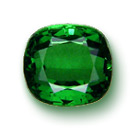Tsavorite: When Garnet is Green

Tsavorite: When Garnet is Green
The gemstone discoveries in East Africa in the 1960s transformed the jewelry world: new varieties, new colors, and new variations on existing species made that decade the most exciting time in the gemstone industry in our lifetimes.
The chain of discoveries was breathtaking: raspberry-red rhodolite garnet, a rainbow of fancy sapphire, rich red ruby, grass-green chrome tourmaline, the sunset hues of malaya garnet, and velvety-blue tanzanite. The grand finale was the discovery in 1968 in Tanzania of a magnificent brilliant green grossular garnet. The beautiful green garnet was also discovered on the Kenya side of the border in 1971, in the Taita Taveta district. In 1974, the new gem was named "Tsavorite," after the famous Tsavo National Park game preserve in Kenya by Tiffany & Co in New York , who introduced the gemstone to the world market.
Tsavorite has a beautiful vivid green color, is bright and lively with a high refractive index, and has a garnet's durability and high clarity.
Tsavorite comes from the East African bush: all the mines currently producing are in an arid grassy area with bare dry hills that runs across the border from Kenya to Tanzania . This area is home to snakes and an occasional lion.
Hundreds of millions of years ago, this land was covered by the ocean. Layers of organic sediment were deposited, eventually forming shale. Then the land was subjected to intense heat and pressure, folding and uplift, metamorphically changing the ocean floor into new minerals. This twisting and torturing of the rocks gave birth to the unusual gemstones of East Africa , many colored by the vanadium which is plentiful in these rocks because of their organic history in the ocean floor.
Green Potatoes
The geology which produces tsavorite is graphitic gneisses, rich in calcium from the seams of marble which lace through them. Tsavorite is often found in pods with a coating of quartz or scapolite, which the miners call potatoes. The green color is most often due to vanadium from the host rock but some tsavorite is also colored by chromium.
The heat and folding of the rock hundreds of millions of years ago which formed tsavorite also shattered most of the crystals. It is very rare to find tsavorite in sizes larger than five carats, and most faceted stones are below two carats. Many deposits of tsavorite are small and unpredictable: seams suddenly narrow and disappear, giving no indication where to look next.
There have been perhaps 40 different areas where tsavorite has been mined but only four mining ventures are still producing in commercial quantities.
The Scorpion Mine in southeast Kenya is now producing from tunnels sunk on an incline for more than 200 feet. The other major producer in this area has a large open-cast operation to a depth of 40 feet which has yielded a considerable quantity of tsavorite. Unfortunately, the owners are unable to continue mining by this method and are beginning to introduce underground mining.
Last year a new tsavorite-producing area was discovered in Lokirima, about a thousand kilometers northwest of the previously known localities. Although this locality is only producing a small quantity, it is promising that the possibility of finding tsavorite exists over a wider area than previously thought.
How Rare is Too Rare?
Tsavorite is cut mostly in Tanzania, Kenya and in Idar-Oberstein. Idar is known for innovative cutting and tsavorite is no exception. The cutting industry in Kenya has also started to offer fancy shapes and a larger range of sizes is available.
Tsavorite's rarity, as well as its beautiful green color, call to mind the queen of the garnet family: demantoid garnet, which was discovered in Russia's Ural Mountains in 1868. Demantoid was also available mostly in small sizes. Mining of this beautiful, brilliant green garnet lasted only about 30 years and the only source for top quality stones today is antique jewelry.
Perhaps the association with demantoid has hurt tsavorite: The rarity of the stone has led jewelers around the world to treat tsavorite as a specialty item, like alexandrite.
One of the tsavorite miners in Kenya has begun a promotional program in conjunction with a dealer in Idar-Oberstein to try to convince jewelers that, in small sizes, tsavorite is reliably available as a durable and attractive green gemstone. The dealer is offering calibrated and fancy-cut tsavorite in unusual shapes as well as a line of tsavorite jewelry with tapered tsavorite baguettes and other surprising uses of tsavorite.
The campaign may be starting to work: Tsavorite has also begun to appear in magnificent invisibly-set jewelry, where its durability and clarity are a distinct advantage.
But tsavorite still needs to break out of a cycle of lack of demand caused by lack of supply. There is potential for mining tsavorite in other areas of Kenya but development of new mining areas, which requires investment in machinery and high operating costs, is unlikely until demand rises. And demand hasn't started to rise because the supply is too limited.
Eventually, the beauty of tsavorite is bound to win over consumers. All they need is to see tsavorite to appreciate its appeal. The recent widening of the market for tanzanite, which came through an increase in the supply available, may convince more retail jewelers to take a chance on tsavorite. Once given this chance, East Africa 's beautiful green garnet will surely find its proper place in the gemstone rainbow

